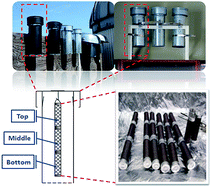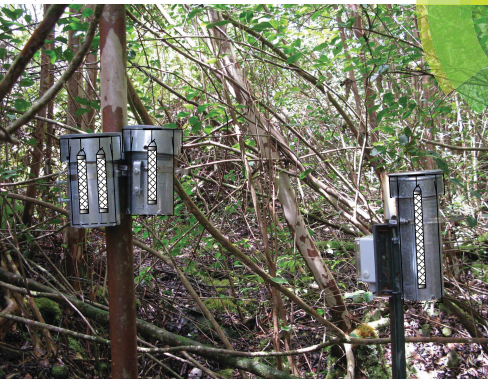Passive air samplers (PAS) have found great utility in monitoring environmental concentrations of semivolatile organic contaminants (SVOCs) all over the world. They provide a picture of longer-term average air concentrations of SVOCs while being relatively portable, low-cost and extremely low-maintenance. Knowing the deployment time, the amount of chemical accumulated in the passive sampling medium (PSM), and the sampling rate derived when a PAS is first calibrated before widespread use, a time-averaged volumetric air concentration can be calculated.
A key assumption underlying the calculation of PAS-derived air concentrations is that the passive sampling medium takes up chemicals uniformly. But this assumption has not been thoroughly tested so far and studies to date have indicated that the sampling rates of some commonly used PSM can differ with position inside a sampler housing. For example, sampling rates decreased with increasing distance from the opening at the bottom of a cylindrical sampler housing for the commonly used styrene-divinylbenzene copolymer or “XAD” resin.
In a study recently published in Environmental Science: Processes & Impacts, Zhang and co-workers at the University of Toronto Scarborough have put their XAD PAS to the test once more to determine if exposure to sunlight, wind, and the presence of multiple units of XAD-filled mesh cylinders in one PAS housing caused differential chemical uptake across the length of a single cylinder.
The chemicals of interest in this series of experiments, polychlorinated biphenyls (PCBs), were chosen because their environmental partitioning properties are inclusive of a range of SVOCs commonly measured in the environment. One indoor experiment included axially segmented PAS at four indoor locations, one of which also used fans to simulate the effect of wind. At one of the indoor locations, a similar experiment was conducted outdoors, where the effect of heat conduction resulting from sunshine was also tested. This involved using PAS with regular housings, housings painted black to enhance heat absorption, and housings shaded by a steel cover.
Two additional experiments varied the number of mesh cylinders inside each housing. One experiment deployed a pair of PAS containing one and four mesh cylinders at one outdoor and one indoor location. A final outdoor experiment attempted to incorporate a variety of temperatures and wind speeds by deploying PAS at nine locations on the Big Island of Hawaii. Each site had one PAS containing one XAD-filled mesh cylinder and another containing two.
In the first indoor experiment, the total amount of PCBs accumulated in all segments was not significantly different from the amount accumulated in a mesh cylinder that had not been segmented. In those cylinders that were axially segmented, the amount of PCBs accumulated in the bottom segments was significantly higher than in the upper two segments in office and storage areas, and assumed to have little activity and therefore air turbulence. But this difference was not significant in the mesh cylinder placed in a cargo-loading area, presumably because of the relatively higher level of activity and therefore air turbulence. Similarly, gradients within PAS deployed outdoors were also not as strong, and the samplers exposed to fans indoors showed no significant gradients – strong indications that increased air turbulence allows for more uniform uptake across the length of the sampler.
The effect of heat convection on total accumulation and axial distribution of PCBs was determined to be minor, as was the presence of multiple mesh cylinders within one housing, but only outdoors. Indoors, the amount of PCB accumulated per sampler was significantly lower in those PAS with four mesh cylinders, and the gradient was also steeper.
The final outdoor deployment across varying temperature and wind conditions in Hawaii, which measured accumulation of PCBs, pesticides, polycyclic aromatic hydrocarbons, and polybrominated diphenyl ethers, showed no significant difference in chemical accumulation in PAS with one versus two XAD-filled mesh cylinders. The finding that uptake of SVOCs by XAD PAS is affected very little by the presence of multiple mesh cylinders in one housing in a variety of outdoor conditions means that fewer housings can be used during a given sampling campaign that uses XAD PAS. This augments the low-maintenance nature of this monitoring method, and thus the value of this particular PAS as a tool for monitoring SVOCs in the environment.
To read the full Open Access article, click the link below:
Exploring the role of the sampler housing in limiting uptake of semivolatile organic compounds in passive air sampler
Xianming Zhang, Michelle Hoang, Ying D. Lei, and Frank Wania
Environ. Sci.: Processes Impacts, 2015, 17, 2006-2012
DOI: 10.1039/C5EM00447K
—————-

About the webwriter
Abha Parajulee is a Ph.D. student at the University of Toronto Scarborough. She is interested in water resources and the behavior of organic contaminants in urban environments.












